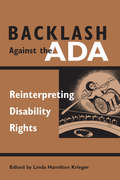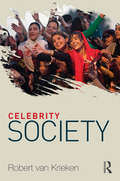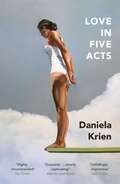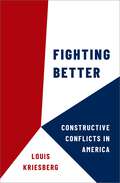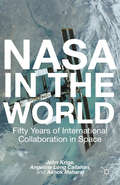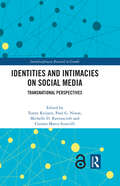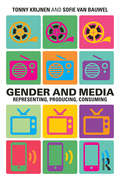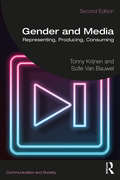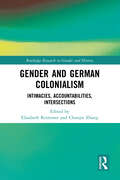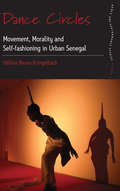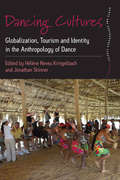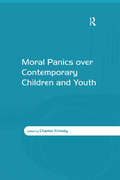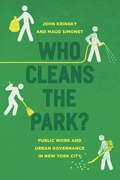- Table View
- List View
Der Weg des Mediums Buch im Zeitalter der Digitalisierung: Eine dreidimensionale Analyse
by Janina KriegerObwohl jeder Lebensbereich von digitalen Prozessen durchdrungen ist, scheint sich die Mehrheit der Deutschen bezüglich der Tätigkeit Lesen gegen digitale Alternativen zu wehren. Das gedruckte Buch genießt weiterhin wesentlich stärkere Beliebtheit als das eBook. Das erscheint verwunderlich, da sich doch das gesamte Kommunikationsverhalten auf digitale Geräte ausgelagert hat. Was also liegt dahinter? Wieso gibt es in digitalen Zeiten immer noch gedruckte Bücher? Bisherige Untersuchungen des gedruckten Buchs konzentrierten sich primär auf seine mediale Zukunft, da diese durch die Digitalisierung bedroht schien. Janina Krieger untersucht in dieser Arbeit stattdessen die Vergangenheit aus drei Perspektiven, um Erkenntnisse über die Gegenwart gewinnen zu können. Während andere Studien stets eine Methode wählten und diese meist dem quantitativen Vorgehen zugehörig waren, werden hier drei Subjekte identifiziert, die mit unterschiedlichen Methoden untersucht werden und in ihrer Kombination eine Antwort auf die Forschungsfrage liefern können: die Konsumenten von Literatur (die Leser), die Literatur selbst (ausgewähltes Genre ist der Roman) sowie die Medientheorien des 20. Jahrhunderts, die sich mit dem Medienwandel bereits auseinandergesetzt haben.
Backlash Against the ADA: Reinterpreting Disability Rights (Corporealities: Discourses Of Disability)
by Linda Hamilton KriegerFor civil rights lawyers who toiled through the 1980s in the increasingly barren fields of race and sex discrimination law, the approval of the Americans with Disabilities Act in 1990 by a nearly unanimous U.S. House and Senate and a Republican President seemed almost fantastic. Within five years of the Act's effective date, however, observers were warning of an unfolding assault on the ADA by federal judges, the media, and other national opinion-makers. A year after the Supreme Court issued a trio of decisions in the summer of 1999 sharply limiting the ADA's reach, another decision invalidated an entire title of the act as it applied to the states. By this time, disability activists and disability rights lawyers were speaking openly of a backlash against the ADA. What happened, why did it happen, and what can we learn from the patterns of public, media, and judicial response to the ADA that emerged in the 1990s? In this book, a distinguished group of disability activists, disability rights lawyers, social scientists and humanities scholars grapple with these questions. Taken together, these essays construct and illustrate a new and powerful theoretical model of sociolegal change and retrenchment that can inform both the conceptual and theoretical work of scholars and the day-to-day practice of social justice activists. Contributors include Lennard J. Davis, Matthew Diller, Harlan Hahn, Linda Hamilton Krieger, Vicki A. Laden, Stephen L. Percy, Marta Russell, and Gregory Schwartz. Backlash Against the ADA will interest disability rights activists, lawyers, law students and legal scholars interested in social justice and social change movements, and students and scholars in disability studies, political science, media studies, American studies, social movement theory, and legal history. Linda Hamilton Krieger is Professor of Law, University of California School of Law, Berkeley.
Celebrity Society
by Robert Van KriekenOn television, in magazines and books, on the internet and in films, celebrities of all sorts seem to monopolize our attention. Celebrity Society brings new dimensions to our understanding of celebrity, capturing the way in which the figure of ‘the celebrity’ is bound up with the emergence of modernity. It outlines how the ‘celebrification of society’ is not just the twentieth-century product of Hollywood and television, but a long-term historical process, beginning with the printing press, theatre and art. By looking beyond the accounts of celebrity ‘culture’, Robert van Krieken develops an analysis of ‘celebrity society’, with its own constantly changing social practices and structures, moral grammar, construction of self and identity, legal order and political economy organized around the distribution of visibility, attention and recognition. Drawing on the work of Norbert Elias, the book explains how contemporary celebrity society is the heir (or heiress) of court society, taking on but also democratizing many of the functions of the aristocracy. The book also develops the idea of celebrity as driven by the ‘economics of attention’, because attention has become a vital and increasingly valuable resource in the information age. This engaging new book will be a valuable resource for students and scholars in sociology, politics, history, celebrity studies, cultural studies, the sociology of media and cultural theory.
Celebrity Society
by Robert Van KriekenOn television, in magazines and books, on the internet and in films, celebrities of all sorts seem to monopolize our attention. Celebrity Society brings new dimensions to our understanding of celebrity, capturing the way in which the figure of ‘the celebrity’ is bound up with the emergence of modernity. It outlines how the ‘celebrification of society’ is not just the twentieth-century product of Hollywood and television, but a long-term historical process, beginning with the printing press, theatre and art. By looking beyond the accounts of celebrity ‘culture’, Robert van Krieken develops an analysis of ‘celebrity society’, with its own constantly changing social practices and structures, moral grammar, construction of self and identity, legal order and political economy organized around the distribution of visibility, attention and recognition. Drawing on the work of Norbert Elias, the book explains how contemporary celebrity society is the heir (or heiress) of court society, taking on but also democratizing many of the functions of the aristocracy. The book also develops the idea of celebrity as driven by the ‘economics of attention’, because attention has become a vital and increasingly valuable resource in the information age. This engaging new book will be a valuable resource for students and scholars in sociology, politics, history, celebrity studies, cultural studies, the sociology of media and cultural theory.
Love in Five Acts
by Daniela Krien"Highly recommended" Sunday Times"Utterly captivating" Woman and Home"Unfailingly impressive" Irish Times"Sparse and precise" Telegraph"A beautiful novel of what it is to be a women in modern Europe" New European"An intelligent study of female desire, ambition and frailty" ObserverBookseller Paula has lost a child, and a husband. Where will she find her happiness? Fiercely independent Judith thinks more of horses than men, but that doesn't stop her looking for love online. Brida is a writer with no time to write, until she faces a choice between her work and her family. Abandoned by the "perfect" man, Malika struggles for recognition from her parents. Her sister Jorinde, an actor, is pregnant for a third time, but how can she provide for her family alone? Love in Five Acts explores what is left to five women when they have fulfilled their roles as wives, mothers, friends, lovers, sisters and daughters. As teenagers they experienced the fall of the Berlin Wall, but freedom brings with it another form of pressure: the pressure of choice. Punchy and entirely of the moment, Love in Five Acts engages head-on with what it is to be a woman in the twenty-first century.Translated from the German by Jamie Bulloch
Fighting Better: Constructive Conflicts in America
by Louis KriesbergThe people in the United States are experiencing an extreme degree of division, political partisanship, and civic disorder. Destructive fights are waged about matters such as misinformation, voting rights, school curriculum, government spending, and personal privacy. How can these distressing circumstances be overcome? More specifically, what makes the difference between conflicts that result in progress versus those that further contribute to a greatly polarized, extremely unequal, and distressed society? In Fighting Better, Louis Kriesberg argues that the crises confronting the US presently are the result of changes in dynamics along three societal dimensions: class, status, and power. Those changes were brought about to a great degree by people waging conflicts constructively, destructively, or avoiding overt conflicts altogether. Assessing major domestic conflicts in the United States since 1945, Kriesberg evaluates how well conflicts were waged in terms of advancing justice, liberty, and equal opportunity for all Americans. Moreover, he offers ideas for how some of those fights might have been waged more effectively and with longer-term benefits, connecting current US crises to past mistakes. In doing so, Kriesberg deepens our understanding of how the way conflicts are waged can help to reduce inequities in class, power, and status, particularly with regard to gender and race.
Fighting Better: Constructive Conflicts in America
by Louis KriesbergThe people in the United States are experiencing an extreme degree of division, political partisanship, and civic disorder. Destructive fights are waged about matters such as misinformation, voting rights, school curriculum, government spending, and personal privacy. How can these distressing circumstances be overcome? More specifically, what makes the difference between conflicts that result in progress versus those that further contribute to a greatly polarized, extremely unequal, and distressed society? In Fighting Better, Louis Kriesberg argues that the crises confronting the US presently are the result of changes in dynamics along three societal dimensions: class, status, and power. Those changes were brought about to a great degree by people waging conflicts constructively, destructively, or avoiding overt conflicts altogether. Assessing major domestic conflicts in the United States since 1945, Kriesberg evaluates how well conflicts were waged in terms of advancing justice, liberty, and equal opportunity for all Americans. Moreover, he offers ideas for how some of those fights might have been waged more effectively and with longer-term benefits, connecting current US crises to past mistakes. In doing so, Kriesberg deepens our understanding of how the way conflicts are waged can help to reduce inequities in class, power, and status, particularly with regard to gender and race.
NASA in the World: Fifty Years of International Collaboration in Space (Palgrave Studies in the History of Science and Technology)
by John Krige Ashok Maharaj Angela Long CallahanSince its inception, NASA has participated in over 4,000 international projects, yet historians have almost entirely neglected this remarkable aspect of the agency's work. This groundbreaking work is the first to trace NASA's history in a truly international context, drawing on unprecedented access to agency archives and personnel.
Identities and Intimacies on Social Media: Transnational Perspectives (Interdisciplinary Research in Gender)
by Tonny KrijnenThis edited collection illuminates the scope with which identities and intimacies interact on a wide range of social media platforms. A varied range of international scholars examine the contexts of very different social media spaces, with topics ranging from whitewashing and memes, parental discourses in online activities, Spotify as an intimate social media platform, neoliberalisation of feminist discourses, digital sex work, social media wars in trans debates and ‘BimboTok’. The focus is on their acceleration and impact due to the specificities of social media in relation to identities, intimacies within the broad ‘political’ sphere. The geographic range of case study material reflects the global impact of social media, and includes data from Belgium, Canada, China, France, Germany, Greece, Italy, Portugal, Spain, Sweden and the USA. This enlightening and rigorous collection will be of key interest to scholars in media studies and gender studies, and to scholars and professionals of social media.
Gender and Media: Representing, Producing, Consuming
by Tonny Krijnen Sofie Van BauwelWhy do some TV genres have the label feminine or masculine? Why do we worry about boys playing video games too much while girls play just as often? Is the TV show Sex and the City empowering or not? Why are recent television shows like Desperate Housewives post-feminist television? Gender and Media explores these and other complex questions by offering a critical overview of the contemporary debates and discussions surrounding gender and mediated communication, and by providing student’s with an overview of the current academic research on these topics. The book is divided into three parts: representing, producing, and consuming with each section made up of three chapters. The first chapter of each section attempts to answer the most basic questions: ‘Who is represented?’, ‘Who produces what?’ and ‘Who consumes what?’. The second chapter of each section draws attention to the complexity of the relationship between gender and media, concentrating on the "why." The third and final chapter of each section addresses the latest debates in the fields of media and gender, adding a vital layer of understanding of the topic at hand. This process is aided by text boxes, which provide some additional information on the most important concepts and topics and exercises, which help bridge the gap between theory and everyday life media practices. This will be an ideal textbook for students studying gender and media, and for general courses on gender studies, sociology, cultural studies and women’s studies.
Gender and Media: Representing, Producing, Consuming
by Tonny Krijnen Sofie Van BauwelWhy do some TV genres have the label feminine or masculine? Why do we worry about boys playing video games too much while girls play just as often? Is the TV show Sex and the City empowering or not? Why are recent television shows like Desperate Housewives post-feminist television? Gender and Media explores these and other complex questions by offering a critical overview of the contemporary debates and discussions surrounding gender and mediated communication, and by providing student’s with an overview of the current academic research on these topics. The book is divided into three parts: representing, producing, and consuming with each section made up of three chapters. The first chapter of each section attempts to answer the most basic questions: ‘Who is represented?’, ‘Who produces what?’ and ‘Who consumes what?’. The second chapter of each section draws attention to the complexity of the relationship between gender and media, concentrating on the "why." The third and final chapter of each section addresses the latest debates in the fields of media and gender, adding a vital layer of understanding of the topic at hand. This process is aided by text boxes, which provide some additional information on the most important concepts and topics and exercises, which help bridge the gap between theory and everyday life media practices. This will be an ideal textbook for students studying gender and media, and for general courses on gender studies, sociology, cultural studies and women’s studies.
Identities and Intimacies on Social Media: Transnational Perspectives (Interdisciplinary Research in Gender)
by Tonny Krijnen Paul G. Nixon Michelle D. Ravenscroft Cosimo Marco ScarcelliThis edited collection illuminates the scope with which identities and intimacies interact on a wide range of social media platforms. A varied range of international scholars examine the contexts of very different social media spaces, with topics ranging from whitewashing and memes, parental discourses in online activities, Spotify as an intimate social media platform, neoliberalisation of feminist discourses, digital sex work, social media wars in trans debates and ‘BimboTok’. The focus is on their acceleration and impact due to the specificities of social media in relation to identities, intimacies within the broad ‘political’ sphere. The geographic range of case study material reflects the global impact of social media, and includes data from Belgium, Canada, China, France, Germany, Greece, Italy, Portugal, Spain, Sweden and the USA. This enlightening and rigorous collection will be of key interest to scholars in media studies and gender studies, and to scholars and professionals of social media.
Gender and Media: Representing, Producing, Consuming (Communication and Society)
by Tonny Krijnen Sofie Van BauwelThis thoroughly revised second edition provides a critical overview of the contemporary debates and discussions surrounding gender and mediated communication. The book is divided into three parts: representing, producing, and consuming, with each section made up of three chapters. The first chapter of each section attempts to answer the most basic questions: ‘Who is represented?’, ‘Who produces what?’, and ‘Who consumes what?’. The second chapter of each section draws attention to the complexity of the relationship between gender and media, concentrating on the 'why'. The third and final chapter of each section addresses the latest debates in the fields of media and gender, adding a vital layer of understanding of the topic at hand. Throughout, text boxes provide additional information on the most important concepts and topics, and exercises help bridge the gap between theory and everyday life media practices. The second edition has been updated in light of current developments with regard to gender, media technologies, and globalisation, including recent theoretical insights and examples. This is an ideal textbook for students studying gender and media, and for general courses on gender studies, sociology, cultural studies, and women’s studies.
Gender and Media: Representing, Producing, Consuming (Communication and Society)
by Tonny Krijnen Sofie Van BauwelThis thoroughly revised second edition provides a critical overview of the contemporary debates and discussions surrounding gender and mediated communication. The book is divided into three parts: representing, producing, and consuming, with each section made up of three chapters. The first chapter of each section attempts to answer the most basic questions: ‘Who is represented?’, ‘Who produces what?’, and ‘Who consumes what?’. The second chapter of each section draws attention to the complexity of the relationship between gender and media, concentrating on the 'why'. The third and final chapter of each section addresses the latest debates in the fields of media and gender, adding a vital layer of understanding of the topic at hand. Throughout, text boxes provide additional information on the most important concepts and topics, and exercises help bridge the gap between theory and everyday life media practices. The second edition has been updated in light of current developments with regard to gender, media technologies, and globalisation, including recent theoretical insights and examples. This is an ideal textbook for students studying gender and media, and for general courses on gender studies, sociology, cultural studies, and women’s studies.
Gender and German Colonialism: Intimacies, Accountabilities, Intersections (Routledge Research in Gender and History)
by Elisabeth Krimmer Chunjie ZhangThis book addresses the intersection between gender and colonialism primarily in German colonialism. Gender and German Colonialism is concerned with colonialism as a historical phenomenon and with the repercussions and transformations of the colonial era in contemporary racist and sexist discourses and practices relating to refugees, migrants, and people of non-European descent living in Europe. This volume contributes to the broader effort of decolonization with particular attention to concepts of gender. Rather than focus on only one European empire, it discusses and compares multiple former colonial powers in context. In addition to German colonialism, some chapters focus on the role of gender in Dutch and Belgian colonialism in Indonesia, Africa, and the Americas. This volume will be of value to students and scholars interested in women’s and gender studies, social and cultural history, and imperial and colonial history.
Gender and German Colonialism: Intimacies, Accountabilities, Intersections (Routledge Research in Gender and History)
by Elisabeth Krimmer Chunjie ZhangThis book addresses the intersection between gender and colonialism primarily in German colonialism. Gender and German Colonialism is concerned with colonialism as a historical phenomenon and with the repercussions and transformations of the colonial era in contemporary racist and sexist discourses and practices relating to refugees, migrants, and people of non-European descent living in Europe. This volume contributes to the broader effort of decolonization with particular attention to concepts of gender. Rather than focus on only one European empire, it discusses and compares multiple former colonial powers in context. In addition to German colonialism, some chapters focus on the role of gender in Dutch and Belgian colonialism in Indonesia, Africa, and the Americas. This volume will be of value to students and scholars interested in women’s and gender studies, social and cultural history, and imperial and colonial history.
Dance Circles: Movement, Morality and Self-fashioning in Urban Senegal (Dance and Performance Studies #5)
by Hélène Neveu KringelbachSenegal has played a central role in contemporary dance due to its rich performing traditions, as well as strong state patronage of the arts, first under French colonialism and later in the postcolonial era. In the 1980s, when the Senegalese economy was in decline and state fundingwithdrawn, European agencies used the performing arts as a tool in diplomacy. This had a profound impact on choreographic production and arts markets throughout Africa. In Senegal, choreographic performers have taken to contemporary dance, while continuing to engage with neo-traditional performance, regional genres like the sabar, and the popular dances they grew up with. A historically informed ethnography of creativity, agency, and the fashioning of selves through the different life stages in urban Senegal, this book explores the significance of this multiple engagement with dance in a context of economic uncertainty and rising concerns over morality in the public space.
Dancing Cultures: Globalization, Tourism and Identity in the Anthropology of Dance (Dance and Performance Studies #4)
by Hélène Neveu Kringelbach Jonathan SkinnerDance is more than an aesthetic of life – dance embodies life. This is evident from the social history of jive, the marketing of trans-national ballet, ritual healing dances in Italy or folk dances performed for tourists in Mexico, Panama and Canada. Dance often captures those essential dimensions of social life that cannot be easily put into words. What are the flows and movements of dance carried by migrants and tourists? How is dance used to shape nationalist ideology? What are the connections between dance and ethnicity, gender, health, globalization and nationalism, capitalism and post-colonialism? Through innovative and wide-ranging case studies, the contributors explore the central role dance plays in culture as leisure commodity, cultural heritage, cultural aesthetic or cathartic social movement.
Die Transnationalisierung der Arbeitswelt am Beispiel von Erwerbsmobilität in der Europäischen Union
by Torben KringsDieses Buch untersucht den Bedeutungswandel innereuropäischer Erwerbsmobilität im 21. Jahrhundert. Im Mittelpunkt stehen die Triebkräfte, die Arbeitsmarktauswirkungen und die Regulierung dieser Mobilität. Es wird gezeigt, dass es in den „postindustriellen“ Gesellschaften Westeuropas eine Nachfrage nach Arbeitskräften mit unterschiedlichen Qualifikationen gibt. Diese Nachfrage wird vor allem durch Zuwanderung aus der erweiterten EU bedient. Allerdings handelt es sich hierbei nicht mehr um die klassische Arbeitsmigration, sondern um die Mobilität von Unionsbürger/innen. Dies bringt neue Gelegenheiten mit sich, aber auch Herausforderungen in einem transnationalen Mobilitätsraum, der auch ein Ungleichheitsraum ist.
Moral Panics over Contemporary Children and Youth
by Charles KrinskyThe concept of moral panic has received considerable scholarly attention, but as yet little attention has been accorded to panics over children and youth. This is the first book to examine this important and controversial social issue by employing a rigorous intellectual framework to explore the cultural construction of youth, through the dissemination of moral panics. It is accessible in manner and makes use of the latest contemporary research by addressing some of the pressing recent concerns relating to children and youth, including cyber-related panics, child abuse and pornography, education and crime. A truly international collection, this volume features new global research focusing on the United Kingdom, Australia, Canada, South Africa, and France as well as the United States. Genuinely multidisciplinary in approach, it will appeal to researchers and students across the social sciences and humanities - from sociology and social theory, to media, education, anthropology, criminology, geography and history.
Moral Panics over Contemporary Children and Youth
by Charles KrinskyThe concept of moral panic has received considerable scholarly attention, but as yet little attention has been accorded to panics over children and youth. This is the first book to examine this important and controversial social issue by employing a rigorous intellectual framework to explore the cultural construction of youth, through the dissemination of moral panics. It is accessible in manner and makes use of the latest contemporary research by addressing some of the pressing recent concerns relating to children and youth, including cyber-related panics, child abuse and pornography, education and crime. A truly international collection, this volume features new global research focusing on the United Kingdom, Australia, Canada, South Africa, and France as well as the United States. Genuinely multidisciplinary in approach, it will appeal to researchers and students across the social sciences and humanities - from sociology and social theory, to media, education, anthropology, criminology, geography and history.
Who Cleans the Park?: Public Work and Urban Governance in New York City
by John Krinsky Maud SimonetAmerica’s public parks are in a golden age. Hundreds of millions of dollars—both public and private—fund urban jewels like Manhattan’s Central Park. Keeping the polish on landmark parks and in neighborhood playgrounds alike means that the trash must be picked up, benches painted, equipment tested, and leaves raked. Bringing this often-invisible work into view, however, raises profound questions for citizens of cities. In Who Cleans the Park? John Krinsky and Maud Simonet explain that the work of maintaining parks has intersected with broader trends in welfare reform, civic engagement, criminal justice, and the rise of public-private partnerships. Welfare-to-work trainees, volunteers, unionized city workers (sometimes working outside their official job descriptions), staff of nonprofit park “conservancies,” and people sentenced to community service are just a few of the groups who routinely maintain parks. With public services no longer being provided primarily by public workers, Krinsky and Simonet argue, the nature of public work must be reevaluated. Based on four years of fieldwork in New York City, Who Cleans the Park? looks at the transformation of public parks from the ground up. Beginning with studying changes in the workplace, progressing through the public-private partnerships that help maintain the parks, and culminating in an investigation of a park’s contribution to urban real-estate values, the book unearths a new urban order based on nonprofit partnerships and a rhetoric of responsible citizenship, which at the same time promotes unpaid work, reinforces workers’ domination at the workplace, and increases the value of park-side property. Who Cleans the Park? asks difficult questions about who benefits from public work, ultimately forcing us to think anew about the way we govern ourselves, with implications well beyond the five boroughs.
Who Cleans the Park?: Public Work and Urban Governance in New York City
by John Krinsky Maud SimonetAmerica’s public parks are in a golden age. Hundreds of millions of dollars—both public and private—fund urban jewels like Manhattan’s Central Park. Keeping the polish on landmark parks and in neighborhood playgrounds alike means that the trash must be picked up, benches painted, equipment tested, and leaves raked. Bringing this often-invisible work into view, however, raises profound questions for citizens of cities. In Who Cleans the Park? John Krinsky and Maud Simonet explain that the work of maintaining parks has intersected with broader trends in welfare reform, civic engagement, criminal justice, and the rise of public-private partnerships. Welfare-to-work trainees, volunteers, unionized city workers (sometimes working outside their official job descriptions), staff of nonprofit park “conservancies,” and people sentenced to community service are just a few of the groups who routinely maintain parks. With public services no longer being provided primarily by public workers, Krinsky and Simonet argue, the nature of public work must be reevaluated. Based on four years of fieldwork in New York City, Who Cleans the Park? looks at the transformation of public parks from the ground up. Beginning with studying changes in the workplace, progressing through the public-private partnerships that help maintain the parks, and culminating in an investigation of a park’s contribution to urban real-estate values, the book unearths a new urban order based on nonprofit partnerships and a rhetoric of responsible citizenship, which at the same time promotes unpaid work, reinforces workers’ domination at the workplace, and increases the value of park-side property. Who Cleans the Park? asks difficult questions about who benefits from public work, ultimately forcing us to think anew about the way we govern ourselves, with implications well beyond the five boroughs.
Who Cleans the Park?: Public Work and Urban Governance in New York City
by John Krinsky Maud SimonetAmerica’s public parks are in a golden age. Hundreds of millions of dollars—both public and private—fund urban jewels like Manhattan’s Central Park. Keeping the polish on landmark parks and in neighborhood playgrounds alike means that the trash must be picked up, benches painted, equipment tested, and leaves raked. Bringing this often-invisible work into view, however, raises profound questions for citizens of cities. In Who Cleans the Park? John Krinsky and Maud Simonet explain that the work of maintaining parks has intersected with broader trends in welfare reform, civic engagement, criminal justice, and the rise of public-private partnerships. Welfare-to-work trainees, volunteers, unionized city workers (sometimes working outside their official job descriptions), staff of nonprofit park “conservancies,” and people sentenced to community service are just a few of the groups who routinely maintain parks. With public services no longer being provided primarily by public workers, Krinsky and Simonet argue, the nature of public work must be reevaluated. Based on four years of fieldwork in New York City, Who Cleans the Park? looks at the transformation of public parks from the ground up. Beginning with studying changes in the workplace, progressing through the public-private partnerships that help maintain the parks, and culminating in an investigation of a park’s contribution to urban real-estate values, the book unearths a new urban order based on nonprofit partnerships and a rhetoric of responsible citizenship, which at the same time promotes unpaid work, reinforces workers’ domination at the workplace, and increases the value of park-side property. Who Cleans the Park? asks difficult questions about who benefits from public work, ultimately forcing us to think anew about the way we govern ourselves, with implications well beyond the five boroughs.
Who Cleans the Park?: Public Work and Urban Governance in New York City
by John Krinsky Maud SimonetAmerica’s public parks are in a golden age. Hundreds of millions of dollars—both public and private—fund urban jewels like Manhattan’s Central Park. Keeping the polish on landmark parks and in neighborhood playgrounds alike means that the trash must be picked up, benches painted, equipment tested, and leaves raked. Bringing this often-invisible work into view, however, raises profound questions for citizens of cities. In Who Cleans the Park? John Krinsky and Maud Simonet explain that the work of maintaining parks has intersected with broader trends in welfare reform, civic engagement, criminal justice, and the rise of public-private partnerships. Welfare-to-work trainees, volunteers, unionized city workers (sometimes working outside their official job descriptions), staff of nonprofit park “conservancies,” and people sentenced to community service are just a few of the groups who routinely maintain parks. With public services no longer being provided primarily by public workers, Krinsky and Simonet argue, the nature of public work must be reevaluated. Based on four years of fieldwork in New York City, Who Cleans the Park? looks at the transformation of public parks from the ground up. Beginning with studying changes in the workplace, progressing through the public-private partnerships that help maintain the parks, and culminating in an investigation of a park’s contribution to urban real-estate values, the book unearths a new urban order based on nonprofit partnerships and a rhetoric of responsible citizenship, which at the same time promotes unpaid work, reinforces workers’ domination at the workplace, and increases the value of park-side property. Who Cleans the Park? asks difficult questions about who benefits from public work, ultimately forcing us to think anew about the way we govern ourselves, with implications well beyond the five boroughs.

